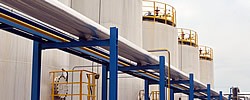The Asia-Pacific region is the world’s largest market for finished lubricants, and with rapidly growing economies, it’s set to leap-frog some other regions to become one of the most pivotal markets for synthetic and semi-synthetic products in the coming years, according to consultancy Kline & Co.
Asia-Pacific held 44 percent of the world’s 39.9 million tons per year of finished lubricants demand in 2014, excluding process oils, United States-based Kline noted recently in its report, “Global Synthetic Lubricant Base stocks: Market Analysis and Opportunities.”
However, the quality of lubricants in the region’s markets is relatively low compared to those in North America and Western Europe. Asia-Pacific encompasses a wide range of markets, including high-quality finished lubricants markets such as Japan, South Korea, and Australia; and markets such as China, Thailand, Indonesia and India, where low- or medium-quality are more prevalent.
The region will continue to be the largest driver of the world’s 1.4 percent compound annual growth in finished lubricant demand to 2019, despite a slowdown in economic growth in the region.
Although the penetration of synthetic and semi-synthetic products in all segments of Asia-Pacific’s lubricant market is only about 10 percent so far, the region presents many opportunities for growth, Kline predicts.
“These markets don’t have tiers in terms of lubricant quality performance, and tend to use conventional base stocks primarily,” said Project Manager Anuj Kumar during a May 20 webinar. “However, in the recent years, even these markets have transitioned to the use of better-quality lubricants. This is primarily driven by original equipment manufacturers demanding better-quality lubricants.”
Passenger car motor oils represent 18 percent of synthetic lubricant demand worldwide, and that number is set to grow as OEMs call more and more for lower viscosity grades in both factory-fill and service-fill recommendations as fuel economy and emissions control requirements become more stringent throughout the world.
While this is especially true in developed markets such as North America and Western Europe, it has a ripple effect in Asia-Pacific as well, as a huge portion of the global passenger car market is dominated by Japanese and other regional OEMs. Asia-Pacific’s demand trend is currently transitioning from 20W- and 15W- PCMOs to 10W- and even 5W- products.
Asian API Group III base stocks suppliers represent some of the world’s largest, with South Korea’s SK and S-Oil having capacity to produce about 20,000 barrels per day and 26,000 b/d within South Korea, respectively. In addition, an SK-Pertamina joint venture plant in Dumai, Indonesia, has 10,000 b/d Group III capacity. The region also has polyalphaolefins producers cropping up, with Naco Lubrication and Shanghai Fox vying for a significant share in the world’s PAO market.
“With Group III in global oversupply, the need for suppliers to differentiate and make unique marketing claims will drive some formulations to PAO despite its higher price, even in low-quality markets in Asia,” Kumar continued. In the high viscosity industrial oil market, considering products such as wind turbine gear oils, PAOs are tight in supply, as they don’t have much competition from any other category of base oils.
Kumar noted a key driver for growth of synthetic lubricants in Asia-Pacific is marketers’ ability to promote the products. It’s also up to marketers to raise awareness about the benefits of these products, to create greater demand for synthetics.
“It’s been observed that in many markets, vehicle owners are not aware of the benefits of synthetic lubes and view them mainly as a costlier alternative,” he concluded. “Synthetic lubes are priced at a premium over conventional and require a high level of marketing activity with a clear message.”
- Products
-

- We are committed to the Lubrication and functional chemicals. Not only the better chemicals, we are also able to offer the high quality technology solutions.
- « Read more

